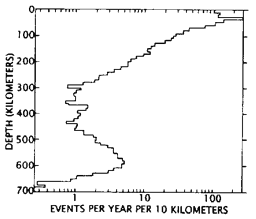 |
Science Frontiers ONLINE No. 62: Mar-Apr 1989 |
|
|
What is exploding 400 miles beneath our feet?
 Earthquake statistics as a function of depth. Obviously, something we do not understand is happening at about 600km. (Adapted from Scientific American, 260:48, Jan 1989. |
Be this as it may, let us see what Frohlich has to say about deep-focus earthquakes. Why are they anomalous? Can't quakes occur at any depth in the earth? No! Because below about 60 kilometers, the rocks should be so hot that they become ductile; instead of breaking catastrophically under stress, they just deform or "flow." It would appear, then, that conditions for earthquakes do not exist below 60 kilometers. Nevertheless, since 1964, more than 60,000 earthquakes have been recorded below 70 kilometers - some as far down as 700 kilometers. Conditions way down there cannot be what we think they are!
Most deep-focus earthquakes occur near subduction zones, where the science of plate tectonics says that the earth's crust is diving below another crustal plate. In addition to this geographical preference, deep-focus quakes are different from shallow quakes in that they produce few if any aftershocks. They are fundamentally different.
We don't really have enough clues as yet to guess just what is going on between 60 and 700 kilometers. If the rocks that far down cannot break to created earthquake shocks, perhaps there are explosions of some sort. There may be something about the rela-tively cool mass of subducted crust that stimulates explosions when it contacts the hot, deep rocks. Possibly, the de-scending crust carries water or other chemicals that react explosively. Complicating the problem are those few deep-focus earthquakes that shake the planet's innards in locations where there are no plates being thrust down into the earth's interior. It is becoming more and more apparent that that part of our planet between the crust and core possesses much more structure than we would have believed a decade ago. Even more, some very energetic events transpire "down there."
(Frohlich, Cliff; "Deep Earthquakes," Scientific American, 260:48, January 1989.)
Reference. Our catalog volume mentioned in the first paragraph is described here.